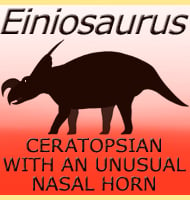Einiosaurus
In Depth The nasal horn of Einiosaurus is quite unusual in that it curves forward to point towards the ground, something which is reflected in the species name E. procurvicornis which translates to English as ‘forward curving horn’. In young Einiosaurus this horn is thought to have started out small, but as the individual grew … Read more
